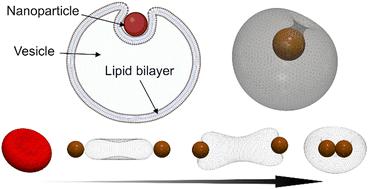当前位置:
X-MOL 学术
›
Soft Matter
›
论文详情
Our official English website, www.x-mol.net, welcomes your feedback! (Note: you will need to create a separate account there.)
Probing wrapping dynamics of spherical nanoparticles by 3D vesicles using force-based simulations
Soft Matter ( IF 3.4 ) Pub Date : 2024-03-13 , DOI: 10.1039/d3sm01600e Didarul Ahasan Redwan 1 , Ke Du 2 , Xin Yong 1
Soft Matter ( IF 3.4 ) Pub Date : 2024-03-13 , DOI: 10.1039/d3sm01600e Didarul Ahasan Redwan 1 , Ke Du 2 , Xin Yong 1
Affiliation

|
Nanoparticles present in various environments can interact with living organisms, potentially leading to deleterious effects. Understanding how these nanoparticles interact with cell membranes is crucial for rational assessment of their impact on diverse biological processes. While previous research has explored particle–membrane interactions, the dynamic processes of particle wrapping by fluid vesicles remain incompletely understood. In this study, we introduce a force-based, continuum-scale model utilizing triangulated mesh representation and discrete differential geometry to investigate particle–vesicle interaction dynamics. Our model captures the transformation of vesicle shape and nanoparticle wrapping by calculating the forces arising from membrane bending energy and particle adhesion energy. Inspired by cell phagocytosis of large particles, we focus on establishing a quantitative understanding of large-scale vesicle deformation induced by the interaction with particles of comparable sizes. We first examine the interactions between spherical vesicles and individual nanospheres, both externally and internally, and quantify energy landscapes across different wrapping fractions of the nanoparticles. Furthermore, we explore multiple particle interactions with biologically relevant fluid vesicles with nonspherical shapes. Our study reveals that initial particle positions and interaction sequences are critical in determining the final equilibrium shapes of the vesicle–particle complexes in these interactions. These findings emphasize the importance of nanoparticle positioning and wrapping fractions in the dynamics of particle–vesicle interactions, providing crucial insights for future research in the field.
中文翻译:

使用基于力的模拟探测 3D 囊泡对球形纳米颗粒的包裹动力学
各种环境中存在的纳米颗粒可以与生物体相互作用,可能导致有害影响。了解这些纳米颗粒如何与细胞膜相互作用对于合理评估它们对不同生物过程的影响至关重要。虽然之前的研究已经探索了颗粒与膜的相互作用,但流体囊泡包裹颗粒的动态过程仍然不完全清楚。在这项研究中,我们引入了一种基于力的连续尺度模型,利用三角网格表示和离散微分几何来研究颗粒-囊泡相互作用动力学。我们的模型通过计算膜弯曲能和颗粒粘附能产生的力来捕获囊泡形状和纳米颗粒包裹的转变。受细胞吞噬大颗粒的启发,我们专注于建立对与大小相当的颗粒相互作用引起的大规模囊泡变形的定量理解。我们首先检查球形囊泡和单个纳米球之间的外部和内部相互作用,并量化纳米粒子不同包裹部分的能量景观。此外,我们还探索了多种粒子与具有非球形形状的生物学相关流体囊泡的相互作用。我们的研究表明,初始粒子位置和相互作用序列对于确定这些相互作用中囊泡-粒子复合物的最终平衡形状至关重要。这些发现强调了纳米颗粒定位和包裹部分在颗粒-囊泡相互作用动力学中的重要性,为该领域的未来研究提供了重要的见解。
更新日期:2024-03-13
中文翻译:

使用基于力的模拟探测 3D 囊泡对球形纳米颗粒的包裹动力学
各种环境中存在的纳米颗粒可以与生物体相互作用,可能导致有害影响。了解这些纳米颗粒如何与细胞膜相互作用对于合理评估它们对不同生物过程的影响至关重要。虽然之前的研究已经探索了颗粒与膜的相互作用,但流体囊泡包裹颗粒的动态过程仍然不完全清楚。在这项研究中,我们引入了一种基于力的连续尺度模型,利用三角网格表示和离散微分几何来研究颗粒-囊泡相互作用动力学。我们的模型通过计算膜弯曲能和颗粒粘附能产生的力来捕获囊泡形状和纳米颗粒包裹的转变。受细胞吞噬大颗粒的启发,我们专注于建立对与大小相当的颗粒相互作用引起的大规模囊泡变形的定量理解。我们首先检查球形囊泡和单个纳米球之间的外部和内部相互作用,并量化纳米粒子不同包裹部分的能量景观。此外,我们还探索了多种粒子与具有非球形形状的生物学相关流体囊泡的相互作用。我们的研究表明,初始粒子位置和相互作用序列对于确定这些相互作用中囊泡-粒子复合物的最终平衡形状至关重要。这些发现强调了纳米颗粒定位和包裹部分在颗粒-囊泡相互作用动力学中的重要性,为该领域的未来研究提供了重要的见解。



























 京公网安备 11010802027423号
京公网安备 11010802027423号